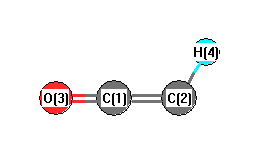Jump to
S1C2
Energy calculated at QCISD/daug-cc-pVTZ
| | hartrees |
|---|
| Energy at 0K | -151.664973 |
| Energy at 298.15K | |
| HF Energy | -151.142186 |
| Nuclear repulsion energy | 52.505136 |
The energy at 298.15K was derived from the energy at 0K
and an integrated heat capacity that used the calculated vibrational frequencies.
Vibrational Frequencies calculated at QCISD/daug-cc-pVTZ
| Mode Number |
Symmetry |
Frequency
(cm-1) |
Scaled Frequency
(cm-1) |
IR Intensities
(km mol-1) |
Raman Act
(Å4/u) |
Dep P |
Dep U |
|---|
| 1 |
Σ |
3469 |
3469 |
120.48 |
|
|
|
| 2 |
Σ |
2094 |
2094 |
241.49 |
|
|
|
| 3 |
Σ |
1304 |
1304 |
20.88 |
|
|
|
| 4 |
Π |
568 |
568 |
1.32 |
|
|
|
| 4 |
Π |
517 |
517 |
3.52 |
|
|
|
| 5 |
Π |
394 |
394 |
27.45 |
|
|
|
| 5 |
Π |
385i |
385i |
111.51 |
|
|
|
Unscaled Zero Point Vibrational Energy (zpe) 3979.9 cm
-1
Scaled (by 1) Zero Point Vibrational Energy (zpe) 3979.9 cm
-1
See section
III.C.1 List or set vibrational scaling factors
to change the scale factors used here.
See section
III.C.2
Calculate a vibrational scaling factor for a given set of molecules
to determine the least squares best scaling factor.
Geometric Data calculated at QCISD/daug-cc-pVTZ
Point Group is C∞v
Cartesians (Å)
| Atom |
x (Å) |
y (Å) |
z (Å) |
|---|
| C1 |
0.000 |
0.000 |
0.020 |
| C2 |
0.000 |
0.000 |
-1.242 |
| O3 |
0.000 |
0.000 |
1.204 |
| H4 |
0.000 |
0.000 |
-2.303 |
Atom - Atom Distances (Å)
| |
C1 |
C2 |
O3 |
H4 |
| C1 | | 1.2614 | 1.1842 | 2.3224 |
C2 | 1.2614 | | 2.4456 | 1.0611 | O3 | 1.1842 | 2.4456 | | 3.5066 | H4 | 2.3224 | 1.0611 | 3.5066 | |
 More geometry information
More geometry information
Calculated Bond Angles
| atom1 |
atom2 |
atom3 |
angle |
|
atom1 |
atom2 |
atom3 |
angle |
| C1 |
C2 |
H4 |
180.000 |
|
C2 |
C1 |
O3 |
180.000 |
Electronic energy levels
Charges, Dipole, Quadrupole and Polarizability
Jump to
S1C1
Energy calculated at QCISD/daug-cc-pVTZ
| | hartrees |
|---|
| Energy at 0K | -151.667697 |
| Energy at 298.15K | |
| HF Energy | -151.141773 |
| Nuclear repulsion energy | 52.346629 |
The energy at 298.15K was derived from the energy at 0K
and an integrated heat capacity that used the calculated vibrational frequencies.
Vibrational Frequencies calculated at QCISD/daug-cc-pVTZ
| Mode Number |
Symmetry |
Frequency
(cm-1) |
Scaled Frequency
(cm-1) |
IR Intensities
(km mol-1) |
Raman Act
(Å4/u) |
Dep P |
Dep U |
|---|
| 1 |
A' |
3350 |
3350 |
38.92 |
|
|
|
| 2 |
A' |
2076 |
2076 |
368.30 |
|
|
|
| 3 |
A' |
1244 |
1244 |
4.17 |
|
|
|
| 4 |
A' |
576 |
576 |
22.84 |
|
|
|
| 5 |
A' |
486 |
486 |
246.98 |
|
|
|
| 6 |
A" |
502 |
502 |
2.64 |
|
|
|
Unscaled Zero Point Vibrational Energy (zpe) 4117.1 cm
-1
Scaled (by 1) Zero Point Vibrational Energy (zpe) 4117.1 cm
-1
See section
III.C.1 List or set vibrational scaling factors
to change the scale factors used here.
See section
III.C.2
Calculate a vibrational scaling factor for a given set of molecules
to determine the least squares best scaling factor.
Geometric Data calculated at QCISD/daug-cc-pVTZ
Point Group is Cs
Cartesians (Å)
| Atom |
x (Å) |
y (Å) |
z (Å) |
|---|
| C1 |
0.000 |
0.055 |
0.000 |
| C2 |
1.083 |
-0.665 |
0.000 |
| O3 |
-1.078 |
0.511 |
0.000 |
| H4 |
2.128 |
-0.428 |
0.000 |
Atom - Atom Distances (Å)
| |
C1 |
C2 |
O3 |
H4 |
| C1 | | 1.3005 | 1.1710 | 2.1822 |
C2 | 1.3005 | | 2.4608 | 1.0718 | O3 | 1.1710 | 2.4608 | | 3.3411 | H4 | 2.1822 | 1.0718 | 3.3411 | |
 More geometry information
More geometry information
Calculated Bond Angles
| atom1 |
atom2 |
atom3 |
angle |
|
atom1 |
atom2 |
atom3 |
angle |
| C1 |
C2 |
H4 |
133.579 |
|
C2 |
C1 |
O3 |
169.331 |
Electronic energy levels
Charges, Dipole, Quadrupole and Polarizability
